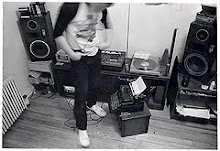 Behringer BCR-2000
Behringer BCR-2000
My
last post really got me thinking about finding a midi controller of my own. It would really help to mix in Ableton Live, which is what I usually use. I'm on a laptop and it's been particularly a pain using the mouse pad to mix. You can't really do things in real-time. Well, maybe one thing. Mostly, you need to set up snapshots and draw curves for fades, and envelopes. It's nice to have all that control, but some actual faders, knobs and buttons would take it to a whole another level.

I came home with the Evolution UC-33 first. For $199 it had faders and buttons, all could be programmed. I was able to set it up pretty easily, but it became clear pretty quickly that when I turned it on every fader was going to be in the wrong place! You touch it and you get a sudden jump in your volume or eq value or whatever you've mapped that partucular controller to. I woke up the next day thinking that it really sucked, if only because of that.

I returned it and got the
Behringer Brc-2000 instead for $139. I thought about the BCF-2000 (F for fader) at first. It's got actual motorized faders. Nice, but for 150 bucks, how good could those motors really be? It was going to break, I figured, so I went for the BCR-2000 (R for rotary).
The BCR also has a lot more controllers on it and they also show the value of the parameter mapped to each knob by lighting up a ring of LEDs. So you get the same function and feedback as the motorized faders, but no motors to worry about. The knobs are infinite, they don't top out, so they are always in the right position.
The main problem, if you can call it that, is that with so many controllers, it's hard to remember what a particular knob or button is going to do. Think about it, there are 32 knobs and 16 buttons in each scene. But the top row of 8 knobs also act as push buttons, and has 4 encoder "groups," making those 8 into 32 knobs and 32 buttons. Add those 64 assignable controllers to the other 24 knobs and you have 88 controllers per scene x 32 scenes and you get over 2800 assignable controllers available! I bet that'll be enough. Of course midi messages can be sent on any of the 16 midi channels so the amount of possible unique messages you can program is just insane. (Oh, I forgot, there are another 4 buttons on the side. I use those for transport functions). I'll lay a strip of tape down, like we do on a big mixing board, and mark it up.
A company in the UK makes markable, erasable plastic overlays for this too.I set mine up in a rough amalgam of the channel strip in LIVE!, with solo and mute buttons, volume, pan and send knobs for each channel, up to 8. Another 8 continue in the next scene. I rarely use more tracks than that. I saved an encoder group on top to address volumes of each of the drums in LIVE!'s drum machine instrument. LIVE! learns the controllers with a little wiggle, so it's easy to set up existing projects to receive the right controllers, and I've set up a blank LIVE! template for new ones. There are free controllers left over for soft synths and real-time tweaking of filters or effects parameters. Quite fun. I haven't felt this knob-happy since I had my
Pro One.So far so good. I've been having a little trouble with some of my virtual synths that lack documentation as to which controllers each of their virtual knobs or buttons receive, but I'm experimenting and figuring some of that out. Additionally, when I got it home I discovered the BCR-2000 is also a full a midi interface for other gear. It's midi ins and outs connect with it's USB port and the computer. Good thing, because with my Mbox and this, there's no USB port left on my laptop for my keyboard controller.
As for the look (mine is the one at the top of this post, it looks more black than blue) — call it retro — the physical design lacks the modernity of Novation's Launchpad or Nocturn controllers — this looks sort of clunky, chunky 90s. That is until the house lights go out and the Christmasy red glow of the manyLEDs begins to charm you. There's even a way to make them act like a UV meter and bounce to the music. I haven't figured that out yet, but I will.
Best $139 I've spent in a long time.
 My Pod Line 6 gave way to the Roland PW-10 Wah pedal. This thing models distortion AND Wah. I really like Roland's modeling, actually. I'm not the only one: BOSS pedals are crazy popular (Boss/Roland: same company) despite the fact that you pay a lot for something that basically does one thing, albeit does it really well and from inside of a super roadworthy metal casing.
My Pod Line 6 gave way to the Roland PW-10 Wah pedal. This thing models distortion AND Wah. I really like Roland's modeling, actually. I'm not the only one: BOSS pedals are crazy popular (Boss/Roland: same company) despite the fact that you pay a lot for something that basically does one thing, albeit does it really well and from inside of a super roadworthy metal casing.



